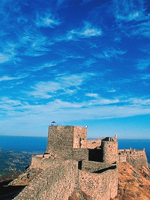Things To Know
The Land
Portuguese Empire
The People
Society and Language
Changing Portugal
Prince Henry the Navigator

Perched on a ridge overlooking the Altenjo valley and the Spanish border, the 13th-century castle of Marvao dominates the
surrounding landscape
© AA Photo Library
|
The Land
For travelers who knew Portugal a couple of decades ago, some things have changed beyond recognition; others remain stubbornly
the same. In many ways Portugal is still old-fashioned and underdeveloped, a real bonus for visitors seeking something a little
different from mainstream European travel. The country is small, diverse and beautiful. Stretching 350 miles from north to
south, it is packed with mountains, plateaus, river valleys, flat dry plains, rolling forested hills and a truly beautiful
coastline. Portugal borders the Atlantic, and weather conditions can range from hot and sunny to stormy and wet. In the northern
Douro region, winter temperatures drop well below freezing; in summer, it is not uncommon for the thermometer to top 100 degrees.
The Algarve, a popular vacation area on the southern coast that's often visited by northern Europeans, enjoys a Mediterranean
climate, and the vegetation is subtropical. On the whole, summers are warm and dry, winters mild and wet, although it can
be cold in the mountains. Portugal's highest mountain is Torre, in the Serra da Estrela, which rises above 6,500 feet. The
Tagus (Tejo) river roughly divides the country in half. The Tagus and two other important rivers, the Douro and the Guadiana,
rise in Spain, and Portugal must share their waters with its bigger neighbor, a factor leading increasingly to difficulties
in supply and environmental problems.
|
|

